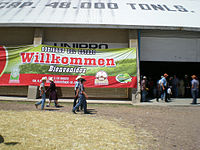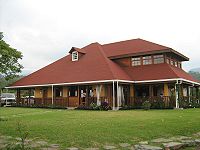- German immigration to Mexico
-
German Mexican
Deutsch-Mexikanisch
Germano-mexicanoTotal population 500,000 Regions with significant populations Mexico City, Chihuahua, Aguascalientes, Puebla, Zacatecas, Durango, Nuevo León, Jalisco, Sinaloa, Chiapas, Yucatán, Quintana Roo. Languages Mexican Spanish, German, Low German
Religion Christianity (mostly Roman Catholic and Protestantism)
Related ethnic groups Germans, German Argentines, German Chileans, German Paraguayans, German Americans, German Canadians
A German Mexican (German: Deutsch-Mexikaner or Deutsch-Mexikanisch, Spanish: germano-mexicano or aleman-mexicano) is a Mexican citizen of German descent or origin. Germans first arrived in Mexico during the mid-to-late 19th century. The majority of them settled in Mexico City and Puebla. Significant numbers of German immigrants also arrived during and after the First and Second World Wars. The Plautdietsch language is also spoken by the descendants of German and Dutch Mennonite immigrants in the states of Chihuahua and Durango. Other German towns lie in the states of Nuevo León, Jalisco, Sinaloa, Chiapas, Quintana Roo, and other parts of Puebla, where the German culture and language have been preserved to different extents.
Contents
Colonization
The German settlement in Mexico goes back to the times they settled Texas when it was under Spanish rule, but the first permanent settlement of Germans was at Industry, in Austin County, established by Friedrich Ernst and Charles Fordtran in the early 1830s, then under Mexican rule. Ernst wrote a letter to a friend in his native Oldenburg which was published in the newspaper there. His description of Texas was so influential in attracting German immigrants to that area that he is remembered as "the Father of German Immigration to Texas." Many Germans, especially Roman Catholics who sided with Mexico, left Texas for the rest of present-day Mexico after Americans defeated Mexicans in Mexican War in 1846. In 1865 and 1866, a total of 443 German-speaking people (men, women, and children) were brought from Hamburg specifically to the villages of Santa Elena and Pustunich, in Yucatán.[1] This was a project of foreign colonization promoted during the Second Mexican Empire, and the reign of Emperor Maximilian I of Mexico, with the governing body of the state of Yucatán. The majority of these people were farmers and craftsmen: wheelwrights, shoemakers, cabinet makers, etc.[2] Other colonies were established in El Mirador, Veracruz by the German botanist Carls Sartorius,[3] and in the state of Tamaulipas by Baron Juan Raiknitz (Johan von Raknitz), in 1833.[4] Sartorius' settlement, known as The Hacienda, attracted more than 200 settlers from Darmstadt, Germany. The Hacienda was visited many times by Maximilian I, and Sartorius was made the Minister of Agriculture under the Empire.
In 1890, Porfirio Diaz and Otto von Bismarck collaborated to take advantage of southern Mexico's agricultural potential by sending 150 German families to Soconusco near Tapachula in the southern state of Chiapas. Extensive coffee cultivation quickly made Soconusco one of the most successful German colonies, and between 1895 and 1900, 11.5 million kg of coffee had been harvested. Fincas were erected in the Chiapaneco jungle and given German names such as: Hamburgo, Bremen, Lübeck, Agrovia, Bismark, Prussia and Hanover.
Twenty-five thousand Germanic Mennonites migrated from Canada to northern Mexico in the 1920s. Today, there are about 95,000 descendants of Mennonites in Mexico, who have preserved the Plautdietsch dialect. German Mexican Mennonite men are allowed to speak Spanish, while women must only speak German. The most prosperous Mennonite colonies in Mexico lie in the states of Chihuahua (Cuauhtémoc, Swift Current, Manitoba), Durango (Patos (Nuevo Ideal), Nuevo Hamburgo), Zacatecas (La Honda) and Campeche.
Nowadays, the German community is a thriving one, and the 2005 Mexican Census counted 180,000 speakers of the German language and over 75,000 speakers of Plautdietsch; up to half a million Mexicans are of full German ancestry.
Cultural legacy
Homes in the town of Nueva Alemania resemble the architectural style of northern Germany, and many of this area's settlers came from the cities of Hamburg, Bremen, and Lübeck. In San Luis Potosí, Sinaloa (Mazatlán) and Veracruz, settlers from Bavaria built structures similar to those found in the Black Forest. The German Cultural Center building in San Luis Potosí is a Bavarian mansion that had been owned by the Baron of Baden-Baden.
Oktoberfest is usually held in several large cities with German-Mexican communities throughout the country, mainly in Mexico City, Chihuahua, and Victoria de Durango. German Mexicans were important in the development of the Mexican cheese and brewing industries. Also of note, the Colegio Alemán Alexander von Humboldt in Mexico City is the largest German school outside Germany.
 German Brewery in Mazatlán, Sinaloa.
German Brewery in Mazatlán, Sinaloa.
German roots are particularly notable in Mexican music due to the large numbers of German immigrants in Texas and northern Mexico around the 1830s. The distributors of German-made accordions aggressively marketed the loud, sturdy little "boom boxes" as far back as the late 19th century. Today, various overlapping styles of music that descended in part from German music (notably polka) include tejano, conjunto, Tex-Mex, quebradita, banda, ranchera, and norteño. Such musical styles are especially popular in northern Mexico and in places of the United States where there is a large immigrant population of Mexican heritage.[5]
The brewing industry, in Monterrey, Nuevo León, was developed in part by German immigrants.[6] The influx of German immigrants and the brief Austrian reign (mid-19th century) of Emperor Maximilian, who never traveled anywhere without his two German brew-masters, helped cement the art of brewing as an all-Mexican endeavor.[7] German influence has had a lasting impact on Mexican beers, with brands such as Negra Modelo and Dos Equis Ambar, both deriving from a malty subset of dark lagers known as Vienna-style.
Notable German-Mexicans
- Kat Von D, tattoo artist, Mexican-born to Argentinian parents of Italian-German descent
- Frida Kahlo, a Mexican painter, her father was born in Germany.
- Guillermo Kahlo, German-Mexican photographer, and father of artist Frida Kahlo
- Vicente Fox, Mexican politician and 55th President of Mexico, of German-American descent
- Dulce María, Mexican singer and actress, her grandmother is Frida's sister of German descent.
- Ozzy Lusth, Mexican-born American actor of German descent
- Max Cetto, German-Mexican architect, historian of architecture, and professor of German-born naturalized Mexican
- Laura Harring, Mexican actress and former Miss USA (1985) of German descent
- Jorge Hank Rhon, Mexican businessman of German descent
- Luis Ernesto Michel, Mexican goalkeeper of Chivas de Guadalajara
- Cristina Fink, retired high jumper of German, Irish, Dutch descent.
- Félix Fernández, retired Mexican football goalkeeper of German Jewish descent.
- Fernando Wagner, German-born Mexican actor and film director.
- María Elena Marqués, Mexican actress, maternal of German descent.
- Sergio Witz, Mexican poet of German descent.
- Emilio Lozoya, Mexican economist and politician of German descent.
- Federico Döring, Mexican conservative politician of German descent.
- Linda Christian, Mexican movie actress of German, Spanish, Dutch and French
- Olga Costa, Mexican painter of German and Russian descent.
- Mauricio Ochmann, Mexican actor of German descent.
- Pedro Friedeberg, Mexican painter.
- John M. Ackerman, Mexican author and professor of American German descent.
- Carlos Hank González, Mexican politician and influential businessman of German descent.
- Kuno Becker, Mexican actor of German, Spanish, Basque descent.
- Hermann Bellinghausen, Mexican physician, poet, writer, and editor of German descent.
- Arap Bethke, Kenyan-born Mexican actor to German father and a Chilean mother.
- Juan Bostelmann, Mexican sprint canoer of German descent.
- Alberto Braniff, Mexican airplane pilot to German father who come to Mexico for work.
- Anna Janzen, A Mexican born Kinesiologist well noted in the scientific community.
Numbers
German net migration to Mexico from 1857 to 1976 Year period German-speaking immigrants 1857–1860 1,256 1861–1870 19,255 1871–1880 10,706 1881–1890 31,804 1891–1900 5,492 1901–1910 10,201 1911–1920 -1,352 1921–1930 739 1931–1940 21,284 1941–1950 2,256 1951–1960 3,934 1961–1970 1,266 1971–1976 85 Total 104,023 See also
- Italian immigration to Mexico
- French immigration to Mexico
- Spanish immigration to Mexico
- Irish immigration to Mexico
References
- ^ Alma Duran-Merk, Los colonos alemanes en Yucatán durante el Segundo Imperio Mexicano. OPUS, Augsburg 2008, http://opus.bibliothek-uni-augsburg.de/volltexte/2008/1329/pdf/Duran_Merk_Colonos-Alemanes_Yucatán.pdf
- ^ Alma Duran-Merk, 2009: Villa Carlota: Colonias Alemanas en Yucatan. Mérida: CEPSA/ICY/CONACULTA
- ^ Beatriz Scharrer, Estudio de caso: el grupo familiar de empresarios Stein-Sartorius, in Los pioneros del imperialismo alemán en México, ed. by Brígida von Mentz et. al. México: Ciesas, 1982
- ^ George Dieter Berninger: La inmigración en México. Mexico: SEP
- ^ Mexican Music, German Roots
- ^ http://www.lib.utexas.edu/benson/border/arhoolie2/raices.html
- ^ Viva cerveza! Mexican brewers have employed German roots and new world style to conquer the US import market
- Buchenau, J. 2002. The Life Cycle of a Trade Diaspora:The German “Colony” in Mexico City, 1821–present. Jahrbuch für Geschichte Lateinamerikas. 39:275-297.
- Buchenau, J. 2001. Small Numbers, Great Impact: Mexico and Its Immigrants, 1821–1973. Journal of American Ethnic History. Spring:24-49.
External links
German people Historical 
Diaspora EuropeTransylvanian Saxons / Landler · Danube / Banat / Satu Mare Swabians · Dobruja · Zipser · Regat · Bessarabia · BukovinaElsewhereCzech Republic (Sudetenland) · Hungary · Bessarabia · Poland · Russia (Volga · Russian Mennonite) · Slovakia · Slovenia (Gottschee County) · Ukraine (Black Sea · Bukovina · Crimea)Balkans and SoutheasternElsewhereArgentina · Bolivia · Brazil · Canada (Hutterites) · Chile · Cuba · Jamaica · Mexico · Paraguay · Peru · United States (Pennsylvania Dutch · Texas · Palatines · Puerto Rico)AfricaNamibia · South Africa (Afrikaners)AsiaOceaniaSee also Ethnic groups in Mexico Mexico 
From Europe From Asia From Elsewhere Categories:- Mexican people of German descent
- Ethnic groups in Mexico
Wikimedia Foundation. 2010.







